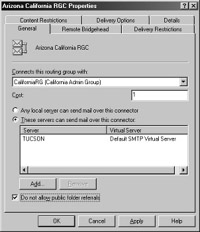Routing Groups and Public Folders
An Exchange 2003 client uses the routing information in the configuration naming partition in Active Directory to locate a public folder server. By default, users will attempt to connect to a public folder replica on their home server and then on another server in the local routing group. If a client attempts to connect to a replica of a public folder that resides on a server in a remote routing group, the connector costs determine the order of the routing groups to which the client is directed. You can also set a flag on a messaging connector to prevent public folder referrals across the link (Figure 3-2), which was not possible with site affinities in Exchange Server 5.5.

Figure 3-2: The property sheet for a messaging connector, showing the Do Not Allow Public Folder Referrals option.
| Note | Connector costs are arbitrary “costs” that you assign to the Routing Group Connector (RGC) to reflect the bandwidth associated with the connector and the amount of messaging you want the connector to receive. For instance, if you have an RGC configured over a T1 link and an SMTP connector over a satellite link, you would assign the RGC a cost of 1 and the SMTP connector a cost of 100. Message routing will attempt to use the lower-cost connector first. |
Let’s look at an example of how this routing works. Suppose that you have three routing groups, each with two servers named Server1 and Server2. In each routing group, Server1 is the e-mail server and Server2 is the public folder server. Sally is a member of routing group A.
Let’s say that Sally attempts to connect to a public folder called Memos in her home routing group. Unfortunately, Server2 in routing group A is down for maintenance. In this instance, Sally is directed across the RGC to the public folders in routing group B and routing group C to access a replica of the Memos folder. If the connector cost on the RGC between routing group A and routing group B is 10, and the connector cost between routing group A and routing group C is 30, Sally will first be sent to routing group B because it has a lower connector cost.
Now let’s say that the physical connection between routing group A and routing group B is severed by a construction crew. The administrator in routing group A could select the Do Not Allow Public Folder Referrals check box on the connector to routing group B, thereby taking that connector out of consideration the next time Sally needs to access the Memos folder. When the line is repaired, the administrator could clear the check box, permitting public folder referrals to once again flow across that connector.
| Tip | Another situation in which it is a good idea to enable the Do Not Allow Public Folder Referrals option is when you know that a public folder server in a remote site is down and will be for a sustained period of time. Selecting this option will eliminate public folder requests across that connector. You might also want to use this option if all instances of public folders are housed in one routing group and you want to focus client traffic on that routing group. In this scenario, all the RGCs that connect to the routing group containing the public folders will have this check box cleared, while all other RGCs will have this check box selected. |
EAN: 2147483647
Pages: 254